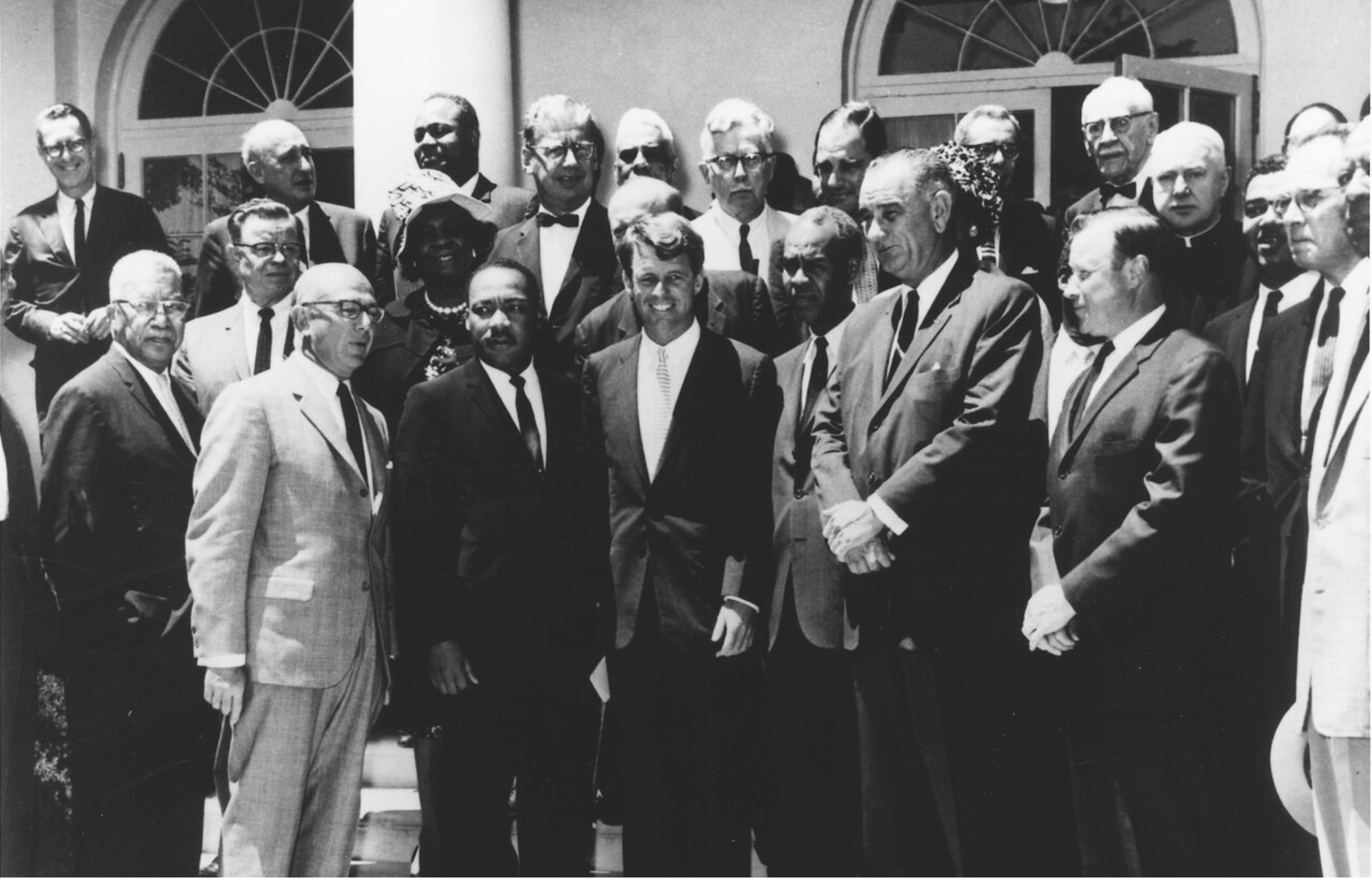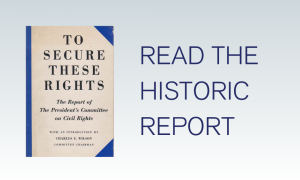TO SECURE THESE RIGHTS
The Civil Rights Report behind President Truman’s Executive Order 9981
By Steven F. Lawson, Professor Emeritus, Rutgers University
INTRODUCTION
In June 1966, President Lyndon B. Johnson convened a White House Conference on Civil Rights. The meeting came at a crossroads for the civil rights movement. After two years of astonishing legislative triumphs that secured passage of the 1964 Civil Rights Act and the 1965 Voting Rights Act, racial polarization gripped the nation with the outbreak of urban rioting among blacks and a resulting white backlash.

Robert F. Kennedy (center, front row) and Lyndon B. Johnson (right of Kennedy) meet with civil rights leaders, including Martin Luther King Jr., on June 22, 1963. Courtesy U.S. National Archives and Records Administration
Amidst this turmoil, the 2,500 delegates attending the White House conference issued a glossy report, To Fulfill These Rights, which was strong on sentiment but weak on pledges of implementation. The title of the report echoed that of To Secure These Rights, a landmark book-length study written by a presidential committee appointed by Harry S Truman nearly twenty years before. If the 1966 document marked the approaching end of the freedom coalition, in 1947, To Secure These Rights loudly proclaimed the opening salvo of the federal government’s campaign for civil rights.
In April 1945, when President Truman entered the White House after the sudden death of Franklin D. Roosevelt, his most immediate concern was to end the war against Germany and Japan. The Nazis surrendered in May, and in early August, Truman inaugurated the nuclear age with the dropping of atomic bombs on Hiroshima and Nagasaki. The devastating conflict that had raged for six years around the globe finally ceased. Not as momentous as atomic weapons in reshuffling the balance of power in foreign affairs, the war nonetheless unleashed forces at home that catapulted African Americans and their struggle for civil rights into the political spotlight.
PART I: THE NEW DEAL COALITION FOR CIVIL RIGHTS
A decade before the war, Franklin D. Roosevelt’s New Deal provided a measure of economic relief and political recognition for African Americans in fighting the Great Depression. New Deal agencies hired influential blacks including the educator Mary McLeod Bethune, the social scientists Ralph J. Bunche and Robert Weaver, and the historian Rayford Logan. They and their fellow black recruits worked hard to challenge programs administered at the local level by white southern segregationists to the disadvantage of African Americans. In 1936, African American voters in great numbers switched their allegiance from the Republican party of Lincoln to the Democratic party of Roosevelt.1
Working alongside the band of blacks who came to Washington were several sympathetic southern whites. Clark Foreman from Atlanta, who headed the National Youth Administration, appointed Bethune to a position in it. He believed racist policies that maintained conservative southern white officials in power not only harmed African Americans but also poor whites, whose racial prejudices had been manipulated to keep them from throwing in their economic lot with poor blacks. Southern white liberals encouraged black and white workers to organize unions and favored abolition of the poll tax requirement for voting in the South, which disfranchised the poor of both races. In addition to the fee necessary for voting, voters had to pay the poll tax well in advance of the election, often before the candidates were announced. Also, states such as Alabama made the tax cumulative: If voters skipped one or more elections, the next time they sought to cast a ballot they had to pay the back taxes.
In 1938, the New Deal inspired white liberals and blacks to form the Southern Conference for Human Welfare (SCHW), which held an integrated meeting in Birmingham, Alabama, in spite of opposition from Police Commissioner Eugene “Bull” Connor. Taking the lead in defying the city’s segregation ordinance was the president’s wife, Eleanor Roosevelt, who attended the meeting. When the police asked Mrs. Roosevelt to move from the black side of the room, where she was sitting, the First Lady picked up her chair and carefully placed it on the line drawn on the floor to separate whites and blacks. In straddling the racial demarcation line, she dramatically took her stand against Jim Crow.2
The SCHW spawned the National Committee to Abolish the Poll Tax, led by Jennings Perry, a Tennessee newspaper editor, and Virginia Durr, a fervent New Dealer from Birmingham, Alabama, and an activist in the women’s division of the Democratic party. Deeply committed to economic and political reforms in the South, Durr had been a driving force behind the creation of the SCHW and worked tirelessly to round up presidential and congressional support to wipe out the suffrage tax. During the 1940s, the committee’s efforts bore fruit in the introduction and passage of several anti—poll tax bills in the House of Representatives only to see them die in the Senate. Nevertheless, reformers achieved victories at the state level in Georgia and Tennessee, which eliminated the franchise levy.3
In the end, the efforts of the Roosevelt administration to advance black equality proved wanting. Primarily concerned with ending the Depression, Roosevelt considered economic recovery a higher priority than civil rights reform and refused to push for legislation to address racial inequality. He endorsed antilynching and anti—poll tax measures but did nothing substantial to engineer their congressional passage. To do so would have angered powerful southern white lawmakers whose support he needed to achieve his larger New Deal programs and his foreign policy objectives to help the Allies fight the fascists in Europe at the end of the 1930s.
NEXT: Part II – The Impact of World War II
Navigate through this essay by section: 1 2 3 4 5 6 7 8 9 10 11 12 13 14 Notes


